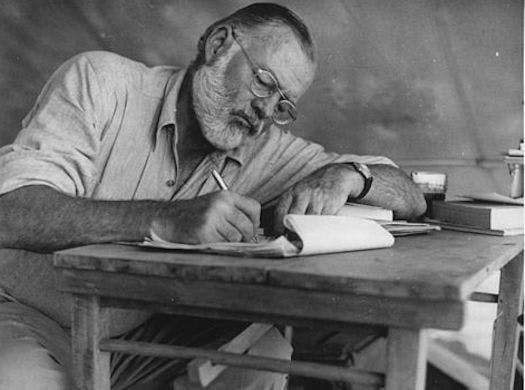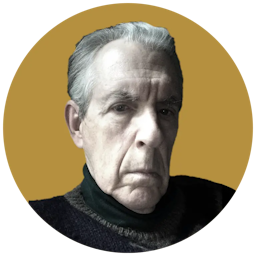Hemingway, the Brand
Litterateurs may not like that vulgar expression, but part of Hemingway’s modernness was his understanding of mass media and of how hard the writer has to work to stay in the public’s consciousness.

More than 60 years after Hemingway’s death, the stream of biographies hasn’t slowed. Both the man and his work are protean; there are more than a dozen biographies and 17 volumes of his letters are projected for publication by Cambridge University Press.
The foundational Ernest Hemingway biography, by Carlos Baker, appeared in 1969. It is a significant, if staid, narrative. A snappier entry, by Jeffrey Meyers, arrived in 1985. The Michael Reynolds quintet (1987, 1989, 1992, 1997, 1999) turned Hemingway into an epic hero, as did Peter Griffin’s works (1985, 1990). Kenneth Lynn (1987) wrote a penetrating psychological study.
Mary V. Dearborn (2017) shows how important women were in shaping Hemingway’s reputation as the Henry VIII of modern literature. If the comparison seems outrageous, bear in mind that he wrote about what it would feel like to have his third wife, Martha Gellhorn, in his rifle sights. Don’t get me started on what the mother-mad Hemingway said about materfamilias Grace.
There are biographies of Hemingway’s wives and assorted other women, by Alice Sokoloff (1973), Bernice Kert (1992), Gloria Dilberto (2011), Caroline Moorehead (2007), Scott Donaldson (2018), Timothy Christian (2022), and yours truly (1990, 2000). Only Pauline, the second wife, has yet to have a biography to herself.
The Hemingway legacy also unfolds in memoirs, beginning with A.E. Hotchner’s controversial “Papa Hemingway” (1960). Then there are the reminiscences of his son, Gregory, and other family members, and the slice-of-life accounts set in Key West, St. Louis, Cuba, Venice, China, on his boat, and so on. What writers can’t document, they concoct in biographical novels, such as Paula McClain’s “The Paris Wife” (2011).
In “The Man Who Wasn’t There: A Life of Hemingway” (2020) Richard Bradford hones in on Hemingway’s lies and on his biographers, suggesting they have missed the point: The man could never tell the truth.
This year, a formidable scholar, Linda Wagner-Martin, has published “Ernest Hemingway: A Literary Life,” and Wylie Graham McLallen is out with the second part of a double decker: “Hemingway and the Rise of Modern Literature,” which, as its title suggests, is a contextual biography.
Mr. McLallen draws some provocative analogies and parallels: “the modern influence became so pervasive that the brutal truths he [Hemingway] learned to portray in his fiction stretched far enough to be a harbinger to the film art of the Coen Brothers and Martin Scorsese. The magnitude of the change is comparable to what Elvis Presley would do in music almost thirty years later.”
These are not throwaway sentences designed to catch the reader’s attention but rather part of an effort to ground Hemingway’s literature into the way we live, imagine, and think. Hemingway’s work, in Mr. McLallen’s book, is not a separate realm, and its connections to other media help to explain why, for example, there is a line of Hemingway furniture, and why Hemingway continues to outsell his contemporaries.
Hemingway has become a “brand.” Litterateurs may not like that vulgar expression, but part of Hemingway’s modernness was his understanding of mass media and of how hard the writer has to work to stay in the public’s consciousness. He broke down, as his predecessors Stephen Crane and Jack London did, the distinction between men of the pen and men of action.
Other writers, like Faulkner — as publicity shy as he pretended to be — realized as early as Hemingway that the writer would need to attract an audience by the way he carried himself. That point is made pithily in a passage Mr. McLallen devotes to Hemingway’s return home from the First World War:
“His right leg still had shrapnel and pain, and he hobbled around town with a cane wearing his uniform with the great cape and boots and cap (interestingly, at this time a young William Faulkner in Oxford, Mississippi, was also wearing a uniform around town, that of the Royal Canadian Air Force, in addition to affecting an English accent, though the war was over for him too).”
The war ended before Faulkner was out of flight camp, so he lied about a life of action involving aerial exploits in order to be in the running as a wounded warrior author. Coming out of the war, these writers had to win an audience, a task inseparable from what Mr. McLallen calls “the Rise of Modern Literature.”
Mr. Rollyson is the author of “Nothing Ever Happens to the Brave: The Story of Martha Gellhorn” (1990) and “Beautiful Exile: The Life of Martha Gellhorn” (2000).

